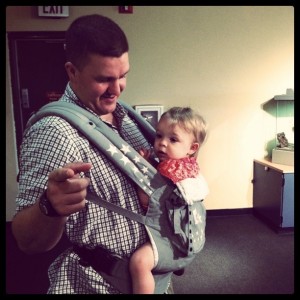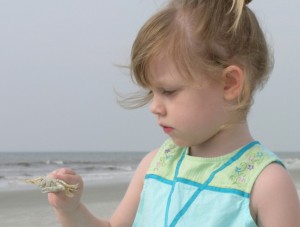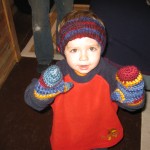The Momosphere is all atwitter over Time Magazine’s cover story: “Are You Mom Enough?” From its “shocking” cover photo to its provocative title, it’s obvious Time was shooting for “mommy war” controversy (something I work hard to stay away from).
If I shy away from controversy, why would I ever agree to the possibility of being on the cover of Time? Because I want to normalize breastfeeding past infancy. Extended does not equal extreme.
People have said that my son (and moreso Jaime’s son, who is on the cover) will be upset or embarrassed someday by this article. But that is the attitude we are trying to change – we do not want the sight of an older nursling to cause a stir ten years from now. By agreeing to be a part of this photo shoot, we wanted to create opportunities for conversation and education about how normal and natural it is to nurture our little ones by nursing past infancy. We want our children to never bat an eye at the sight of a mother breastfeeding past infancy.
So how can one photo stir up such controversy and negativity? And why would any mother choose to nurse for longer than a year?
The Decision to Breastfeed – For Three Months or Three Years – Is Culturally Influenced
Western culture tends to focus on the sexual aspect of the female breast much more than on its biological role of breastfeeding, despite the fact that we are mammals. The word “mammal” is derived from mammary glands. Mammary glands are those amazing parts of our breasts, the primary purpose of which is to feed our young. So while we often hear about nursing moms being asked to leave or cover up, you rarely hear about petitions to have Victoria Secret ads removed from evening television or city billboards. Go figure, eh?
In addition to our culture’s fascination with breasts as sexual objects, breastfeeding is also “modified by a wide variety of [cultural] beliefs, not only about infant health and nutrition, but also about the nature of human infancy and the proper relationships between mother and child, and between mother and father1.”
That must explain many of the objections I’ve read whenever there is an article about nursing past infancy. There are vague complaints about it being “too sexual.” That it encourages children to be overly dependent on mothers. That it is somehow at odds with a child’s development (ever heard the one about children old enough to “ask” should not be nursing?).
Nursing older children, however, is not a new thing. Not only is there evidence that mothers have nursed past toddlerhood throughout human history (and have been recommended to by physicians!), but cultures around the world continue to nurse to three years or beyond today2. If nursing past infancy were a harmful practice, the human race would not have flourished so.
And so while the “median age of weaning throughout the world is between ages three and five[,]” here in North America we are weaning our children when they are far younger.
Breastfeeding Beyond Infancy Benefits Children and Mothers
The biologically normal benefits of breastfeeding do not magically disappear once a baby turns a year old. Breastmilk still provides nutrition that is far superior to cow milk. It contains an abundance of antibodies. “In fact, some of the immune factors in breastmilk increase in concentration during the second year and also during the weaning process3.”
Think about it like this:
Suppose you have an oil well in your back yard. Like all oil wells, its yield is highest in the first year. You get a check for $100,000 dollars. Great! So now do you cap the well? The next year you get a check for only $10,000. Do you cap the well? The next year you get a check for $1,000. Do you cap the well? The next year you get a check for $100. Do you cap the well? [The] point [is], the well will *always* yield a benefit. . .
Breastfeeding works something like that. Its nutritional and immunological importance wanes over time. But there’s never, never a time when it’s not a good food or a good source of antinfectives. And, of course, this analogy doesn’t address the emotional value, the place breastfeeding has in the mother-child relationship4.
For the record, the American Academy of Family Physicians has said: “As recommended by the WHO, breastfeeding should ideally continue beyond infancy, but this is not the cultural norm in the United States and requires ongoing support and encouragement. It has been estimated that a natural weaning age for humans is between two and seven years.”
So this idea of a mother breastfeeding her three or four year old as unnatural? It’s incorrect.
Breastfeeding can continue to be a normal, healthy part of your relationship with your child into toddlerhood and beyond. It has been one reason that my son counts my embrace as the most secure, loving place he knows. (He told me!)
Did you breastfeed past infancy? Why or why not?
References, and for more information
1. Jen Davis, <a href=”http://www.lalecheleague.org/nb/nbsepoct07p196.html”>Breastfeeding Beyond a Year: exploring benefits, cultural influences, and more</a> quoting Dettwyler, K.A. “A Time to Wean” in Breastfeeding: Biocultural Perspectives. Hawthorne, NY: Aldine de Gruyter, 1995.
2. For more on these studies, check out Breastfeeding Beyond a Year and the studies cited therein (along with the reference to physicians recommending extended breastfeeding), A Natural Age of Weaning by Kathryn Dettwyler, Natural Weaning by Norma Jane Bumgarner, and ChildInfo.org.
3. Extended Breastfeeding Fact Sheet (citing Goldman AS. et al., Immunologic Components in Human Milk During Weaning, Acta Paediatr Scand. 1983 Jan;72(1):133-4; Goldman, A., Goldblum R.M., Garza C., Immunologic Components in Human Milk During the Second Year of Lactation, Acta Paediatr Scand 1983 May;72(3):461-2; Hamosh M, Dewey, Garza C, et al: Nutrition During Lactation. Institute of Medicine, Washington, DC, National Academy Press, 1991, pp. 133-140)] The longer you breastfeed, the less risk you have of developing breast cancer, endometrial cancer, or ovarian cancer.[6. See Extended Breastfeeding Fact Sheet and citations therein, and 101 Reasons to Breastfeed Your Child and citations therein.
4. Nursing Past a Year at The Compleat Mother




 Children learn about death from many sources, but they learn about grieving from the people they love most.
Children learn about death from many sources, but they learn about grieving from the people they love most.


